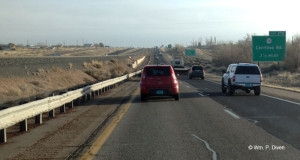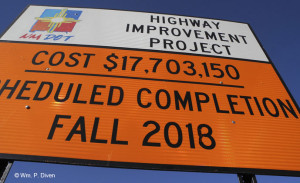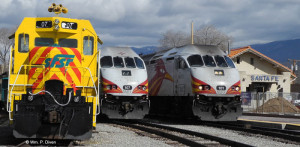Interstate 25 during the morning rush to Santa Fe intimidated the woman in the VW enough she couldn’t make up her mind about the 75 mph flow in the right lane. So she opted to speed up, slow down and randomly apply the brakes, slowing and braking just as I started to pass her by shifting into the 85 mph left lane. I barely dodged her and squeezed into the faster stream as a pickup grill quickly filled my rear-view mirror. What surprised me about the pickup driver wasn’t the on-my-bumper tailgating but his inattention when I turned on my blinker. I really expected him to speed up in an attempt to plug the hole in his lane before I could dive into it.
By Tuesday morning enough time had passed I’d almost forgotten how much one risks life and limb in the morning stampede from the south into the capital. Last time I checked the numbers a few thousand commuters from Rio Rancho came east across the Rio Grande each morning struggling to get through the town of Bernalillo to reach the interstate and turn left into the northward wave from Albuquerque. At Bernalillo three lanes become two, and Death Race I-25 begins.
It’s only 36 miles from Bernalillo to the first of three Santa Fe exits, but buckle your seatbelt, gird your loins and watch your como se llama. New Mexicans drive angry like too many rats packed in a cage preying on the weak and eating their own.
Despite Santa Fe’s artsy charm and internationally known opera, or perhaps because of those, a lot of folks who work in state government and elsewhere can’t afford to live there. Others endure the commute because the median price of homes in Albuquerque and Rio Rancho is about four BMWs cheaper than Santa Fe where the average buyer settles for a stick-built stucco with Southwest accents and gang graffiti, not a rambling adobe with Saltillo tile floors, exposed vigas and walled courtyard.
The Legislature, my intended target, is in session, although budget cuts have reduced traffic by slashing state employment. But first came the
preliminary event. I had to get to I-25 through the semi-permanent construction project rebuilding the Bernalillo interchange handled by the same state contractor who sailed a year past the announced completion date for widening I-25 to six lanes south of here. This project was supposed to be done months ago, and despite an unusually mild winter still has a long way to go. I had a long way to go, too, lining up out of sight of the freeway behind Albuquerque-bound commuters until I got close enough to reach the frontage road by going cross-country. Maybe in my idle hours whenever this project is done I’ll tally how long it will take the meager decrease in commute times to make up the thousands of hours lost to constructions jams.
I know this whine is wasted on folks in high-density metro areas with biblical traffic snarls. Still, I-25’s two northward lanes challenge the faint of heart where tailgating and NASCAR-style drafting are the norm, and caffeinated zombies mix with tourists, heavy trucks and viejos in beater pickups. The police presence always increases during the Legislature. It’s mostly a proper show of force that doesn’t slow high-stepping legislators who successfully interpret the constitutional prohibition against their arrest during a session for anything except for treason, felony or breach of the peace to include speeding (Article IV, Section 13, Privileges and Immunities). County deputies and state officers do patrol some, unlike Albuquerque where a cop on the freeways creates a safety hazard by disrupting the flow.
About halfway to Santa Fe you crest La Bajada grade with the capital visible in the distance and New Mexico Rail Runner Express tracks running down the median. No commuter trains whiz by in either direction, and the system lumbers along with little promotion or political leadership and no love from Gov. Susana Martinez. There has been chatter in the past about expanding the Belen-Albuquerque-Santa Fe Rail Runner west to Gallup, northeast to Las Vegas and even south to Las Cruces, but all is quiet for now. The major transportation plan afoot in this Legislature raises the gas tax by 5 cents for 10 years to fund $300 million in highway projects, widening I-25 to Santa Fe not among them (House Bill 74 with list of projects). Probably won’t happen, though, since the Republican governor hates tax increases almost as much as she hates the Rail Runner, a pricey legacy of the previous Democratic administration. No promises, though. We’ll soon see how much sway the highway-building lobby has with the current administration.
In a progressive world where state elected leaders might look for a way to enhance the community, promoting and expanding commuter rail service would be seen as a public benefit. It might also delay the inevitable push to expand those 36 miles of I-25 north of Bernalillo to six lanes at a cost probably approaching the half billion or so it took to launch Rail Runner. The traditional way to relieve crowded highways, of course, is to build more soon-crowded highways. Once commuter rail is established, however, it’s a long time before you need more track. You just add trains.
(Note the previous Republican Gov. Gary Johnson knocked out governor and Democratic legend Bruce King in 1994 in part because King had the temerity to raise the gas tax by 6 cents for highway building and maintenance after tribal enterprises exempt from the tax began peddling petrol. Johnson promptly cajoled the Legislature into repealing the tax, and the underfunding of highway maintenance began. Democrat Gov. Bill Richardson accelerated the skid by tapping multiple revenue sources to float $1.5 billion in borrowing to fund his projects including Rail Runner.)
Much of the impasse over properly funding commuter rail and Amtrak stems from a fallacy in play when Amtrak saved the dying national passenger network in 1971. That sell claimed Amtrak would eventually pay for itself, a ludicrous assertion at the time that helped provide cover for more yes votes and poisoned the debate ever since. No matter that it was the feds who all but killed passenger rail by deciding to shift the U.S. Mail and its revenue away from privately funded railroads to subsidized airlines. Every country with rail service, perhaps excepting Japan, subsidizes its passenger trains with no prospect of turning a profit.
For what it’s worth, China sees value in rail investing $200 billion in the last couple of years to expand a network that includes magnetic-levitation passenger trains that near 300 mph. It’s also worth noting commuter rail stops draw economic development although the state-built building at one of the Bernalillo stations remains vacant. But even if elected leaders here don’t recognize the value of public transit, voters in seven New Mexico counties did by approving sales taxes to fund the Rio Metro and North Central regional transit districts, Rail Runner and some of its connecting bus services. Rail Runner claims 100,000 passenger boardings a month across its system with trips to Santa Fe dropping along with government employment.
So why didn’t I take the train Tuesday? That was the plan, actually, until a meeting away from the Capitol blew up my intended schedule. At least that gave me something to write about and got me out of Santa Fe before the southbound Death Race began.





Re The rail runner and the current GOP administration — Where is the money to replace the existing locomotives and cars? Not in anybody’s plans for anything.
This is a serious problem that NOBODY in Santa Fe wants to address, but heavy maintenance and replacement is due in less than a year.
Railrunner started service in 2007 and now it’s 2014. Seven years to figure out how to cover heavy maintenance and locomotive replacement. Guess what? Under the Martinez administration, we still have NO dollars set aside for this necessary work. Proves to me that the GOP does not want to govern but just grand stand like getting rid of licenses for our guest workers.